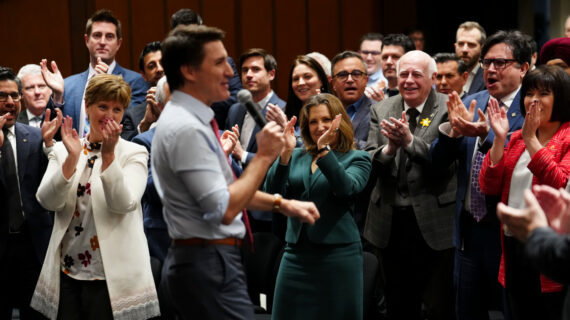Today’s Hub Dialogue is with Montreal Economic Institute policy analyst Krystle Wittevrongel about her recently published two-part series on carbon capture, utilization, and storage technology and how it can help Canada achieve its climate change goals.
This conversation has been revised and edited for length and clarity.
SEAN SPEER: Krystle’s new papers on carbon capture, utilization, and storage technology for the Montreal Economic Institute are a fascinating and important read. Thanks for joining us.
KRYSTLE WITTEVRONGEL: Thank you for having me.
SEAN SPEER: Why don’t we just start with some basic information for readers: What do carbon capture, utilization, and storage technology do in a nutshell?
KRYSTLE WITTEVRONGEL: Well, in a nutshell, this impressive suite of technologies captures and uses, or captures and stores, carbon emissions, ultimately preventing their release into the environment. The amount of emissions that CCUS can capture is significant. Some projects have reported supporting between about 85 and 100 percent withholding of the emissions that would otherwise have been emitted.
In addition, they can also capture carbon that has already been emitted into the air, which reduces the overall atmospheric accumulation, and is what has been called “negative emissions”—the idea that technology doesn’t just have a net-neutral effect on emissions but can actually generate negative emissions.
SEAN SPEER: How viable is the technology and what role can it play in helping Canada to achieve its emission reduction goals?
KRYSTLE WITTEVRONGEL: Well, the technologies have been around for decades at different stages in the innovation and development process. It’s just a matter of getting into more large-scale deployment and in different industrial contexts.
This is important because, of course, the federal government is committed to the goal of net-zero emissions by 2050. The Prime Minister recommitted to this goal at the recent COP-26 meetings in Glasgow. This means that in practice that we won’t be able to emit greenhouse gas emissions, or we can offset them by some means. The former will be difficult to do without significant effects on economic activity, employment, and living standards. The latter can be done with CCUS technologies. We can effectively offset emissions rather than being relegated to emitting no emissions at all.
SEAN SPEER: This is an important point for readers. Canada’s net-zero goal will presumably be achieved by some combination of much lower emissions intensity (effectively lowering or eliminating emissions) and technological processes for capturing and sequestering emissions. Can you please elaborate a bit on the distinction between achieving the net-zero target through the elimination of carbon emissions versus utilizing CCUS and other technologies to store and utilize emissions that are being produced in the economy?
KRYSTLE WITTEVRONGEL: We simply cannot eliminate all of our greenhouse gas emissions unless there is a huge shutdown of heavy industry. It would represent a huge drain on and detriment to the Canadian economy. Take the steel and cement industries for example. They contribute about 20 percent of Canada’s overall GHG emissions annually. While they can make strides on reducing their emissions intensity, we are not at a place technologically where there are options that would enable them to continue production at current levels while significantly reducing or eliminating emissions altogether. That’s just currently not an option.
CCUS represents an alternative. Rather than reducing or eliminating, it can offset some of these emissions, and in turn, contribute to the net-zero goal without shutting down these industries. It should therefore be seen as a meaningful part of Canada’s net-zero plans.
SEAN SPEER: Do you have a sense of where Canada stands relative to other countries in the development of CCUS technologies? In addition to the important climate-related applications that you’ve just described, is there also an opportunity to develop a domestic advantage and ultimately export these technologies abroad?
KRYSTLE WITTEVRONGEL: When we look at CCUS, often the storage part of the carbon capture, utilization, and storage can be done in the geological formations that oil and gas have already been extracted out of it. That means that we have abundant geological storage.
We have also developed industry expertise and the technical capacity to become a real leader in CCUS. We do have a number of CCUS facilities within Canada, including some large-scale ones. There are also some smaller commercial operators, particularly in direct air capture or capturing from already emitted carbon.
The point is, to answer your question, between some geological advantages and first-mover advantages in terms of industry expertise and technological know-how, there’s a real opportunity for us to develop and build up our already existing capacity.
SEAN SPEER: What are the economics of CCUS technology? Is there a role for public policy to address investment uncertainty, solve for externalities, or target any other factors that may be leading to underinvestment in this technology by the private sector?
KRYSTLE WITTEVRONGEL: That’s a really good question. While we have all of this potential, there are these high, front end and high operating costs that can definitely discourage uptake and large-scale deployment. This is obviously an issue given the potential climate change benefits that CCUS technologies represent.
The good news is that the more that you start to deploy these technologies, the more the costs start to fall until it becomes more feasible and more relevant to broader climate change objectives. In that context, there is a role for policy to help narrow the cost curve and reach that equilibrium where the market will fully support it.
The federal government has talked about incentives to encourage and enable commercial CCUS in the context of capping emissions. The idea is that targeted incentives can help incentivize entrepreneurs to tilt some of these projects into market viability.
The recent federal budget announced a CCUS tax credit coming into play in 2022 that will provide an incentive for capital invested in a CCUS project. However, there are certain exclusions under the credit as proposed and still some outstanding questions about that tax credit. One, for instance, is the treatment of what are called “enhanced oil recovery projects” which capture and store a great amount of carbon but are deemed ineligible simply because they involve extraction. This is an exclusion that, in my view, should be eliminated. If oil extraction can be made less carbon-intensive, there’s no reason to try to suppress that.
Within consultations for the development of this investment tax credit, the government asked if the design should encourage or ensure a certain performance standard, like for example, the amount of sequestration per dollar of investment. Realistically, if a tax credit is to be tied to performance, it makes a lot more sense to roll it out separately, and not link it to the capital that is being invested.
So, if we look at currently what’s been done in the United States, they have a performance-based tax credit, which is based on the amount of carbon that is captured and stored, and they broadly offer the tax credit for each metric ton. If we were to do something similar in Canada, we could apply it to our current carbon tax with either a credit or a tax preference based on net emissions.
It’s worth noting that we’re seeing that Canadians are increasingly more supportive of these technologies. Just recently the MEI released a poll that we had recently commissioned of Canadians generally, and Quebecers more specifically, about their attitudes regarding the most important issues that are facing Canadians today. We saw that the issue of climate change is the third most important topic to Canadians, and nearly 70 percent of Quebecers think that CCUS technologies should occupy a bigger place in their provincial climate change strategy. But even more notable is that of those who think that climate change is one of their top three priorities, more like 80 percent support CCUS. So, people are starting to become aware of what CCUS technologies can do, and they think that they should be prioritized. So, there is a place for policy, and I think we’re starting to see some appetite for it as well.
SEAN SPEER: One of the policy-related issues that you raise in your paper is the question of whether a tax-based incentive ought to be refundable or non-refundable. Do you want to just elaborate for readers why you think there’s a case that when the government ultimately rolls out its tax incentives in 2022, that they come in the form of a refundable tax credit?
KRYSTLE WITTEVRONGEL: Well, I think that is mainly based on the economic evidence that non-refundable tax credits tend to favour incumbent firms. So, newcomers or smaller companies that don’t that have sizeable tax liabilities wouldn’t benefit as much from a non-refundable tax credit as they would from a refundable tax credit. And so, in this context, it levels the playing field and allows the smaller company or the newcomer to CCUS to provide them with that incentive as well.
SEAN SPEER: Just one last question. We’ve talked so far about a role for the federal government in supporting investment in CCUS technology, and you also mentioned the potential for CCUS to be deployed in Quebec and elsewhere. Is there a role for provincial governments? And if so, are you seeing any best practices or models at the provincial level that other provinces may want to draw upon?
KRYSTLE WITTEVRONGEL: This is a really great question, and I know that there are some differences between the provinces. It’s an evolving and interesting policy landscape.
Currently, Canada is home to about 15 percent of global CCUS facilities, with another couple of huge projects in the works. Historically, there have been both federal and provincial measures that have supported the deployment of CCUS technologies.
I know Alberta recently announced $176 million in funding for emission reduction projects under the Technology Innovation and Emissions Reduction Regulation, or TIER, to reduce emissions from large industrial emitters. We also have a bilateral working group in Alberta between the provincial and federal governments to collaborate and leverage Alberta’s expertise to support the advancement of CCUS technologies.
Other provinces like Saskatchewan have also announced CCUS priorities and the aim to attract private sector investment.
Ultimately, yes, there is a role for provincial governments and for policy to be tailored to the specific needs of those provinces. As I mentioned earlier, there are regional industrial emitters that need to be considered. It’s not just about the oil and gas sector in Alberta when it comes to CCUS. The steel and cement industries will benefit from CCUS technologies because we know that at this point we lack the options to eliminate these emissions. Considering about 20 percent of our overall emissions are represented by cement and steel alone and cement production is fairly concentrated in Ontario and Quebec, there is benefit to be had.
SEAN SPEER: Thank you, Krystle, for taking the time to speak to us. Congratulations on this series, which readers can find on MEI’s website. We appreciate you taking the time to share these key insights with us and our readers.
KRYSTLE WITTEVRONGEL: Thank you again for having me, it’s been a pleasure.




